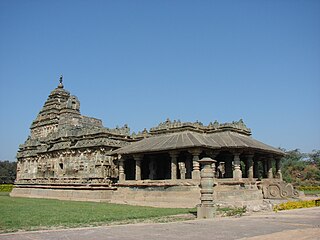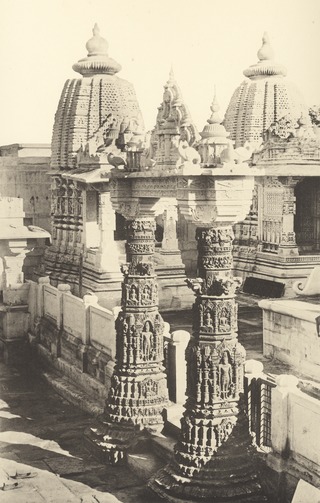
Vidisha is a city in central Madhya Pradesh, India. It is located 62.5 km northeast of the state capital, Bhopal. The name "Vidisha" is derived from the nearby river "Bais", mentioned in the Puranas.

Grishneshwar Jyotirlinga Temple, sometimes referred to as the Ghrneshwar or Ghushmeshwar Temple, is one of the shrines dedicated to Lord Shiva that is referenced in the Shiva Purana, and one of the 12 Jyotirlingas.

The Udayagiri Caves are twenty rock-cut caves near Vidisha, Madhya Pradesh primarily denoted to Hindu gods Vishnu and Shiva from the early years of the 5th century CE. They contain some of the oldest surviving Hindu temples and iconography in India. They are the only site that can be verifiably associated with a Gupta period monarch from its inscriptions. One of India's most important archaeological sites, the Udayagiri hills and its caves are protected monuments managed by the Archaeological Survey of India.

The Great Living Chola Temples is a UNESCO World Heritage Site designation for a group of Chola dynasty era Hindu temples in the Indian state of Tamil Nadu. Completed between early 11th and the 12th century CE, the monuments include - Brihadisvara Temple at Thanjavur, Brihadisvara Temple at Gangaikonda Cholapuram and Airavatesvara Temple at Kumbakonam.

Sonagiri or Swarnagiri about 60 km from Gwalior, has scores of Jain temples dating from the 9th century onwards. It is located in the Datia district of Madhya Pradesh, India. This location is popular among devotees and ascetic saints to practice self-discipline, and austerity and to attain Moksha. This place also has a Jain museum.

Chaturbhuj Temple, dedicated to Vishnu, is situated at Orchha in Madhya Pradesh, India. The name Chaturbhuj is a combination of 'chatur' meaning "four" and 'bhuj' meaning "arms" which literally translates to "one who has four arms" and refers to Rama an Avatar of Vishnu. The temple has a complex multi-storied structural view which is a blend of temple, fort and palace architectural features.

Gyaraspur is a town in the Vidisha district, Madhya Pradesh, India. It is also the headquarters of a tehsil of the same name.

The Lal Mandir is an old Hindu temple in the locality of Shobhabazar, at the crossing of Raja Nabakrishna Street and Jyotindra Mohan Avenue of Kolkata, India. It is said to be built by the Raja of Shobhabazar. It is located near Sobhabazar Metro Station entrance.

The Brahma Jinalaya, sometimes called as the Greater Jain Temple of Lakkundi, is an early 11th-century Mahavira temple in Lakkundi, Gadag District of Karnataka state, India. The temple is attributed to Attiyabbe, the wife of the local governor Dandanayaka Nagadeva. It faces east, has a mukhamandapa, a gudhamandapa and its sanctum is covered by a sur-temple style vimana superstructure. The temple is notable for its reliefs depicting Jaina artwork, statues of the Tirthankaras and the two Hindu statues of Brahma and Saraswati inside its inner mandapa.

Chandraprabha or Chandranatha is the eighth Tirthankara of Tīrthaṅkara of Jainism in the present age. According to traditional accounts, he was born to King Mahasena and Queen Lakshmana Devi at Chandrapuri to the Ikshvaku dynasty. According to Jain texts, his birth-date was the twelfth day of the Posh Krishna month of the Indian calendar. He is said to have become a siddha, a liberated soul which has destroyed all of its karma.

Parshvanatha temple is a 10th-century Jain temple at Khajuraho in Madhya Pradesh, India. It is now dedicated to Parshvanatha, although it was probably built as an Adinatha shrine during the Chandela period. Despite the temple's Jain affiliation, its exterior walls feature Vaishnavaite themes. The entrance has an inscription with a most-perfect magic square. It is part of a UNESCO World Heritage Site along with other temples in the Khajuraho Group of Monuments.

Jain Basadi complex in Halebidu, Hassan district consists of three Jain Basadis dedicated to the Jain Tirthankars Parshvanatha, Shantinatha and Adinatha. The complex is situated near Kedareshwara temple and Dwarasamudra lake. These temples were constructed in the 12th century during the reign of Hoysala Empire along with Kedareshwara temple and Hoysaleswara Temple have been proposed to be listed under UNESCO World Heritage Site. The temple complex also includes a step well called Hulikere Kalyani.

Jama Masjid is a historic mosque in Mandu in the Central Indian state of Madhya Pradesh. Built in Mughal style of architecture, the mosque has been believed to have been built during the reign of Hoshang Shah and completed during the reign of Mahmud Khilji in 1454.

The Mahavira Jain temple is built in Osian of Jodhpur District, Rajasthan. The temple is an important pilgrimage of the Oswal Jain community. This temple is the oldest surviving Jain temple in Western India and was built during the reign of Mahārāja Śrī Vatsarāja of Imperial Pratihāras. The temple is visited by both Jain and Hindu.

Vidisha is considered to be Puranakshetras Jain tirtha. The Jain temples are located in Vidisha district in state of Madhya Pradesh, India. According to Jain belief, Vidisha is the birthplace of Shitalanatha, the tenth tirthankar. Here the first 108 feet elevated temple with all Tirthankaras with Shitalanatha as the principal deity is under construction.

Maladevi Temple is a Jain temple located in Gyaraspur town of Vidisha in state of Madhya Pradesh, India.

Chavundaraya basadi or Chamundaraya basadi or Boppa-Chaityalya is one of the fifteen basadis located on the Chandragiri Hill in Shravanabelagola in the Indian state of Karnataka. Archaeological Survey of India has listed the Chavundaraya basadi in group of monuments in Shravanabelagola as Adarsh Smarak Monument.

Gadarmal Devi temple is a Hindu and Jain temple at Badoh village of Vidisha, Madhya Pradesh.

The Humcha Jain temples or Humcha basadis are a group of temples found in Humcha village of Shimoga district in Karnataka, India. They were constructed in the 7th century CE in the period of the Santara dynasty and are regarded as one of the major Jain centres of Karnataka. The Padmavati Basadi is the most well-known of these temples.

Pisanhari ki Marhia is a Jain temple built in the 15th century and located in the city of Jabalpur in Madhya Pradesh, India. The temple is named after its creator, a local woman who, according to legend, paid for the construction of the temple with the money she saved from milling flour. Many other temples have since been added making this a tirtha.
























